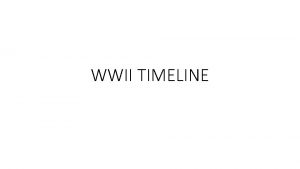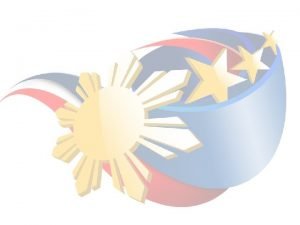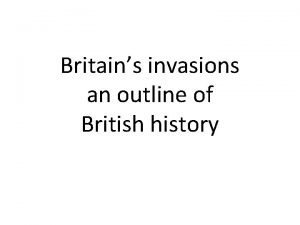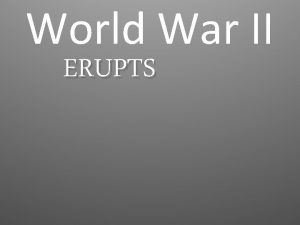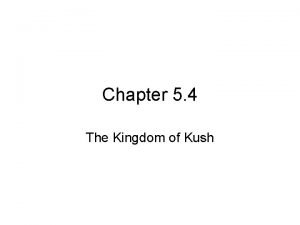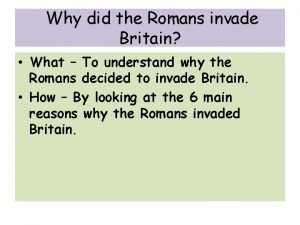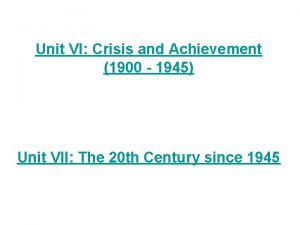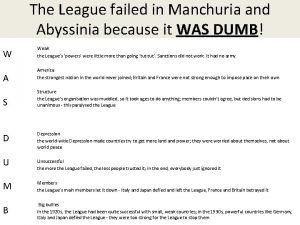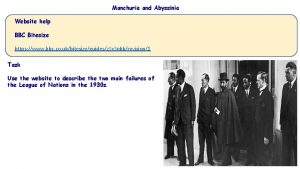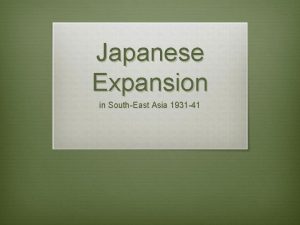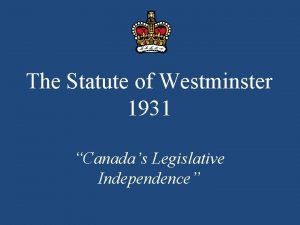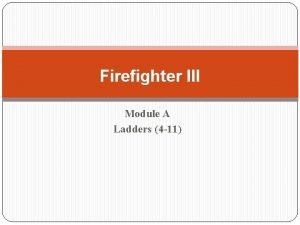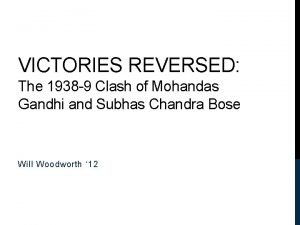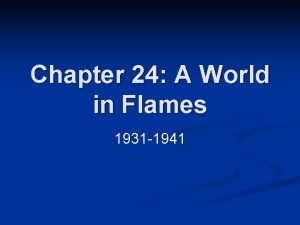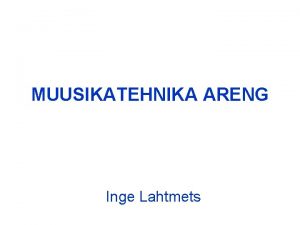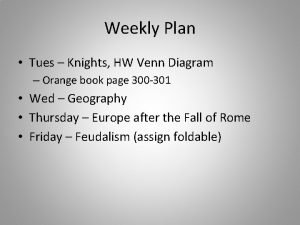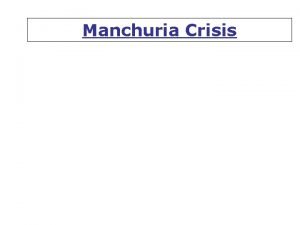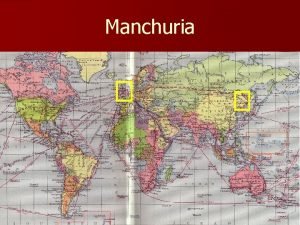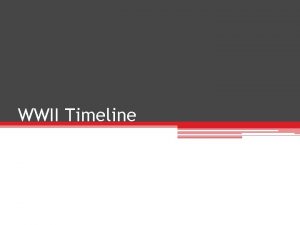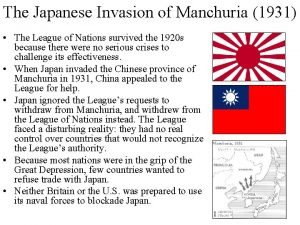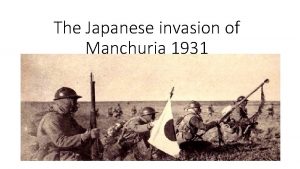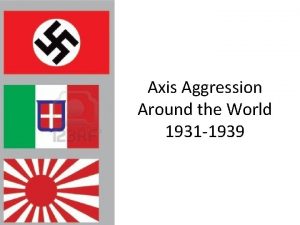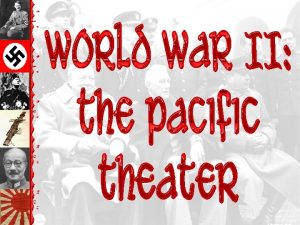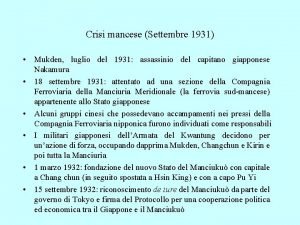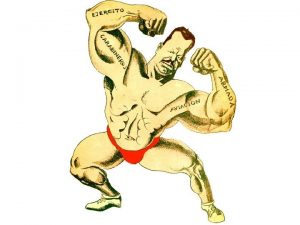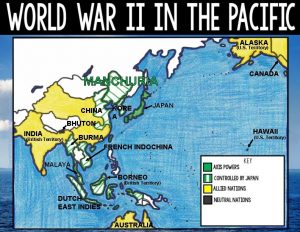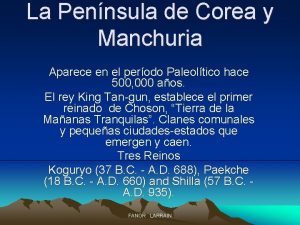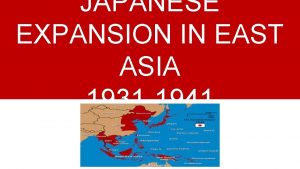Japan u Japan invaded Manchuria in 1931 u





























- Slides: 29


Japan u Japan invaded Manchuria in 1931 u War begins between Japan & China – Interrupts Communist Revolution in China u Japan drops out of the League of Nations u becomes a member of the Axis powers

Japan Why? u Geography: lack of natural resources u The Western powers gained control in the Pacific through imperialism. u Japan’s Manifest Destiny was to control the Pacific.

u The U. S. & Japan only obstacle to Japan’s Pacific empire is the US. u U. S. determined to keep Japan from taking over China u Japan threatened Philippines islands, Singapore, Malaya, & Indonesia. u U. S. passes trade embargo against Japan

The Date that will live in infamy u. Japan declared war and attacked Pearl Harbor on Sunday, December 7, 1941 at 7: 55 a. m. u 18 ships sunk, 170 planes destroyed, over 2, 400 Americans killed, 1, 200 wounded u. Japan also attacked Guam, Wake, Midway,

Pearl Harbor: 2 D map Pearl Harbor: 3 D map

“Yesterday, Dec. 7, 1941 - a date which will live in infamy - the United States of America was suddenly and deliberately attacked by naval and air forces of the Empire of Japan”. . . “No matter how long it may take us to overcome this premeditated invasion, the American people in their righteous might will win through to absolute victory” President Franklin Roosevelt December 8, 1941


The U. S. Enters the War P“A Day that will Live In Infamy” according to President Roosevelt PU. S. declared war on Japan on December 8, 1941, and on Germany December 9, 1941. PSoon after Germany and Italy declared war on the U. S.

U. S. Pacific Strategy: Defensive until Germany is defeated Island Hopping: Taking strategically located islands one at a time, using each as a base to attack the next.

Island Hopping u The U. S. would invade selected islands and use them as bases to attack others. u Japan started winning several victories after Pearl Harbor ex. Philippines & Coral Sea. u The battle of Midway was turning pt of Pacific front (turns the tide).

American Propaganda

Japanese Propaganda

Philippines - January 1942 Invasion following Pearl Harbor General Mac. Arthur forced to flee to Australia. Over 11, 000 U. S. soldiers captured & forced on the Baatan Death March

Battle of Coral Sea - May 1942 First aircraft carrier battle (planes vs. ships) Stops Japanese advancement to Australia

Battle of Midway - June 1942 2 nd aircraft carrier battle U. S. sinks 4 aircraft carriers; 1 Japanese ship turning point in the Pacific stops threat to Hawaii (retribution for Pearl Harbor)

USS Yorktown at the Battle of Midway

Guadalcanal - August 1942 first amphibious landing in Pacific first U. S. offensive; first land lost by Japan gains important islands for strategic bombing U. S. wins, but has high causalities

Saipan - June 1944 puts B-29’s in striking range of Japan long battle with high causalities

Leyte Gulf - October 1944 triggered by retaking of Philippines marks the end of Japan’s challenge to U. S. naval superiority -both sides suffered heavy causalities

Iwo Jima - February 1945 over 5, 000 Americans killed marked the beginning of the end

Raising of the flag on Mt. Suribachi at Iwo Jima

Okinawa. April 1945 last U. S. amphibious assault intended to be a base for invasion of Japan The bloodiest land battle of the war – The last island hold before possibly invading mainland Japan

USS Lexington, Ranger, Yorktown, & Enterprise only aircraft carrier that survived from Pearl Harbor to Okinawa

Animated Map

The Atomic Bomb u The US. regained Philippines and invaded Iwo Jima and Okinawa u An attempt for US. to continue would mean over a year of fighting and more casualties. u dropped A-Bomb on Hiroshima August 6, 1945 u 3 days later dropped bomb on Nagasaki

Japan Surrenders August 14, 1945, Emperor Hirohito announced, “I cannot bear to see my innocent people suffer any longer. ” WWII was over

Japanese delegation at the surrender on the USS Missouri in Tokyo Bay

Mac. Arthur signs the treaty to end WWII.
 1931
1931 Sudantenland
Sudantenland Epekto ng digmaan sa silangan
Epekto ng digmaan sa silangan Doggeland
Doggeland Airforce
Airforce Raging martians invaded venus using x-ray guns
Raging martians invaded venus using x-ray guns Where did the kushites settle
Where did the kushites settle In 331 bce, alexander the great successfully invaded egypt.
In 331 bce, alexander the great successfully invaded egypt. Why did the romans invaded britain
Why did the romans invaded britain Wheres manchuria
Wheres manchuria Manchuria
Manchuria Manchuria and abyssinia
Manchuria and abyssinia Manchuria crisis bbc bitesize
Manchuria crisis bbc bitesize Manchuria apush
Manchuria apush De stijl 1917-1931
De stijl 1917-1931 Growth of the japanese empire, 1931–41
Growth of the japanese empire, 1931–41 1931 electric guitar
1931 electric guitar Statute of westminster 1931
Statute of westminster 1931 Nfpa 1931
Nfpa 1931 Indian flag in 1931
Indian flag in 1931 A world in flames, 1931-1941
A world in flames, 1931-1941 Sda fundamental beliefs 1931
Sda fundamental beliefs 1931 Charles sheeler, classic landscape, 1931.
Charles sheeler, classic landscape, 1931. Surrealist artists were interested exploring
Surrealist artists were interested exploring Picasso dod
Picasso dod Daimler co ltd v continental tyre case summary
Daimler co ltd v continental tyre case summary Marius (1931)
Marius (1931) Gobiernos militares de el salvador 1931 a 1979
Gobiernos militares de el salvador 1931 a 1979 Ameerika leidur 1847-1931
Ameerika leidur 1847-1931 The samurai of japan and european knights reading answer
The samurai of japan and european knights reading answer
